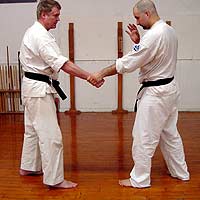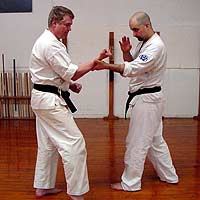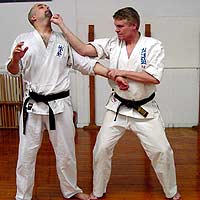Escaping The Wrist Grab
Part 1 - From The Same Side
by Christopher Caile

Wrist grabs are a basic attack. They are found in aikido,
jujutsu systems and daito-ryu aikijutsu. And they are taught as part of
self-defense in most karate systems and within self-defense courses.
At one time self-defense and escape techniques from wrist grabs, pins
or pulls were critical to survival. In medieval times the primary weapon
was a knife and/or a sword or swords --carried in easy access through
a belt, in a scabbard or elsewhere on the body. Incapacitating a wrist
could stop a weapon from being withdrawn, or provide a critical second
of incapacitation for an attacker to use his or her weapon. Martial arts
that were developed prior to the 20th century thus naturally incorporated
a variety of wrist attacks and other manipulations.
Today, however, wrist grabs rarely relate to weaponry unless the weapon
is a beer bottle, club or baseball bat. More often than not, today assailants
use wrist grabs for control, usually by a much larger, stronger person
against a smaller weaker one -- such as a male assailant pulling a women
or a child, or a parent controlling an offspring. Of course, in many martial
arts the wrist and elbow might be grabbed for an arm manipulation after
a strike, but this is a different story.
This series will explore a variety of simple wrist grabs, from the same
side, from across the body and two hand grabs. This first article will
examine the simple front wrist grab such as an attacker's left hand grabbing
the right wrist of someone. The escapes here demonstrated are simple and
effective. They are also compared. Because of space many techniques common
to aikido and/or jujutsu systems have not been discussed.
First, let it be said that there are a literally hundreds of possible
escapes and self-defense techniques that are taught and practiced. Some,
however, are better than others. And what is used is also dictated by
the attack -- a static grab and hold versus a grab and pull. What works
in one situation doesn't necessarily work in another.
 One
of the most common defenses (shown here) is to use your free hand to grab
the top of your fist and then pull back against the attacker's grip and
in particular against the attacker's thumb -- the weak link in most wrist
grabs. The advantage in this defense is that in pulling back you also
pull the attacker's shoulder forward which can inhibit a punch by the
other arm. Also, as you sink back you can move your weight to back foot,
allowing a front snap kick (not shown) by your front foot. From this position
you can also easily run away. One
of the most common defenses (shown here) is to use your free hand to grab
the top of your fist and then pull back against the attacker's grip and
in particular against the attacker's thumb -- the weak link in most wrist
grabs. The advantage in this defense is that in pulling back you also
pull the attacker's shoulder forward which can inhibit a punch by the
other arm. Also, as you sink back you can move your weight to back foot,
allowing a front snap kick (not shown) by your front foot. From this position
you can also easily run away.
There are a couple of disadvantages to this technique, however. If the
defender is small and significantly weaker, the pull back might not be
sufficient to break free. In addition, if the attacker is pulling in,
a weak pull back might actually propel the defender further into the attack
instead of breaking free. And of course, this technique still leaves the
defender in front of the assailant and open to a potential strike or attack
by the other arm. If you pull back, even if you free yourself from the
attacker's grip and don't continue to distance yourself further, your
movement backward unfortunately places you at perfect kicking range of
the attacker.
 Another,
and slightly different, self-defense is instead of pulling back, to first
rotate your wrist and arm so as to turn the attacker's wrist so the palm
is up and the elbow is down. Another,
and slightly different, self-defense is instead of pulling back, to first
rotate your wrist and arm so as to turn the attacker's wrist so the palm
is up and the elbow is down.
As a test, rotate your own arm in this way (a position common to an inside
or outside block in karate). Notice how there comes a point that neither
the wrist nor arm can rotate any further. This is the position that you
want to move your attacker's arm into. It is also simple to do. The attacker
is not concentrating on this directional move (as he or she would be with
a pull back). Additionally the muscles involved are not very powerful.
If you combine your arm turn with a kiai (shout) or defensive movement
with your free hand, the opponent's concentration will be broken and the
movement will be easier to do.
As you turn your arm over, support your fist with the palm of your free
arm and then step forward (here, with the right foot) to the side of the
attacker.  This
allows you to use your whole body weight against the thumb of the attacker's
gripping hand that, along with the arm, is locked in position by the preceding
move. This
allows you to use your whole body weight against the thumb of the attacker's
gripping hand that, along with the arm, is locked in position by the preceding
move.
Here you are not expending muscle power against muscle power, but instead
letting your body's weight and movement do the work. And if you want to
counter attack, you can raise your left elbow (not shown) to do an elbow
attack against the attacker's head or face.
Their are several benefits of this technique. It takes less strength.
It can be done if the attacker is pulling in, and it can also incorporate
a counter attack (elbow to face or head). A disadvantage, however, is
that the defender is still potentially open to a strike or other offensive
technique from the attacker's free arm. A kick is less likely, however,
since you have maneuvered to the attacker's side.
Both of the techniques shown above allow a defender to break free. Both,
however, are vulnerable to an attack from the assailant's free arm and
neither establishes control over the attacker. For this reason I personally
favor a self-defense technique similar to that seen in many renditions
of the karate kata Saiha. I was shown one such technique while researching
kata applications on Okinawa. It is illustrated below.
As soon as the opponent grabs your wrist, you begin to step forward with
your right foot as you pivot to the outside around the attacker's grasping
wrist. This is also a basic defensive move in aikido that allows you to
get to the outside of the attacker and lead the attack.
The Saiha kata move, however, is somewhat different. In this application
you support your own arm with your other hand. This turns your opponent's
wrist over into a similar position as done in the technique above, but
it also moves you away from any potential attack by the assailant's other
fist while manipulating the assailants arm so it is impossible (unless
he lets go) of turning towards you to attack. Notice (close up) how the
attacker's wrist moves inward (hand outward) which forces the attacker's
elbow inward and restricts body movement.
 As
you continue to rotate, snap your own elbow (with your whole body weight
behind it) against the outside/bottom of the attacker's elbow. If done
with a quick snapping action this movement will damage your attacker's
elbow, or break it, before the arm pops upward and away from you -- so
be very careful when practicing this technique. The attacker's left wrist
will now be close to your own left hand and within easy reach. Grab the
attacker's wrist. As
you continue to rotate, snap your own elbow (with your whole body weight
behind it) against the outside/bottom of the attacker's elbow. If done
with a quick snapping action this movement will damage your attacker's
elbow, or break it, before the arm pops upward and away from you -- so
be very careful when practicing this technique. The attacker's left wrist
will now be close to your own left hand and within easy reach. Grab the
attacker's wrist.
Once you have grabbed the attacker's wrist drop backward into a horse
stance. Don't step. By releasing your left knee and letting your weight
drop, your can let your weight pull the opponent's arm down, and with
it the head will be pulled forward, allowing you to strike with a right
backfist to the chin or face of your attacker (that drives the head backward).
 Here
you have both taken control of your attacker while simultaneously mounting
a counter attack. Here
you have both taken control of your attacker while simultaneously mounting
a counter attack.
This dropping motion that lets gravity do the work, and that uses muscles
only to halt movement (rather than generate it), is one of the forgotten
secrets used by some of the old karate masters. It was also the basis
of the traditional body movement underlying the Japanese Samurai tradition.
(1)
This technique has the advantage of movement away from a second offensive
technique, of using your own weight and movement to achieve an escape,
while also (if desired) being able both to take control of the opponent
and mount a counter attack -- all as part of one quick and powerful movement
sequence.
A variation of this techniques involves how the defender can react in
case the attacker is somehow is able to punch at you with his right fist?
Eiichi Miyazato (the Okinwan master who was one of the prime students
of Chojun Miyagi's Goju-ryu karate system) showed me how at this point
your left arm could be extended to intercept and block this attack (instead
of grabbing the left arm as is illustrated) while at the same time doing
the same backfist to the attacker's face.
This article can only touch on several viable alternative self-defense
techniques that can be used against the wrist grab. If you have another
application that you think is practical, you can send it to FightingArts.com
through the Comments section following this article.
Footnote:
(1) In Hakuhokai Daito-Ryu Aikijujutsu
(Daito-Ryu, a jujutsu system, being one of, if the oldest, of Japan's
continually practiced martial arts systems) which incorporates within
its teaching curriculum the Aizu (Japanese Clan through which Daito-Ryu
was transmitted) sword art, Ona Ha Itto Ryu Kenjutsu, the founder Okabayashi
Shogen emphasizes this method of moving the body and transmitting force
without the use of strength. This method of body movement, common to pre-Meiji
era (pre-1868) martial arts, was based on high level techniques developed
for cutting and stabbing with the sword. Aikido inherited this concept
from Daito-Ryu. Although this method of body movement is used in a much
more restricted method, in Aikido it is a principle concept of the art.
Likewise, some of this concept of movement was incorporated into the karate
that developed on Okinawa and is still taught in some systems, such as
in Okinawa Karate Do Shorin Ryu Kishaba Juku. Joe Swift, the well-known
karate historian and Associate Editor of FightingArts.com, has translated
a book by Matsuo Kanenori Sakon Sensei, "Ryukyu ke Hiden Bujutsu"
in which the author notes this same concept of movement within old Okinawan
karate. In my own Seido Juku karate system founded by Kaicho Tadashi Nakamura,
Nakamura uses this same dropping of the body method when moving back into
a horse stance for this technique, as illustrated above.
About The Author:
Christopher Caile is the Founder and Editor-In-Chief of FightingArts.com.
He has been a student of the martial arts for over 40 years and holds
a 6th degree black belt in Seido Karate and has experience in judo,
aikido, diato-ryu, boxing and several Chinese fighting arts. He is also
a long-term student of one branch of Traditional Chinese Medicine, Qigong.
He is a personal disciple of the qi gong master and teacher of acupuncture
Dr. Zaiwen Shen (M.D., Ph.D.) and is Vice-President of the DS International
Chi Medicine Association. In Buffalo, NY, he founded the Qi gong Healing
Institute and The Qi Medicine Association at the State University of
New York at Buffalo. He has also written on Qi gong and other health
topics in a national magazine, the Holistic Health Journal and had been
filmed for a prospective PBS presentation on Alternative Medicine. Recently
he contributed a chapter on the subject to an award winning book on
alternative medicine, "Resources Guide To Alternative Health."
|